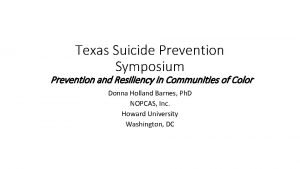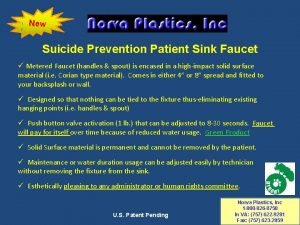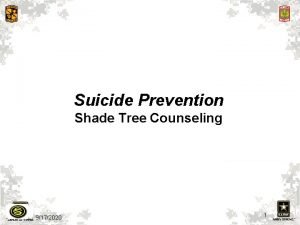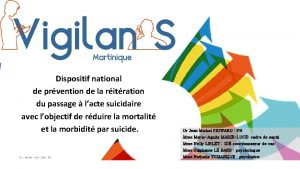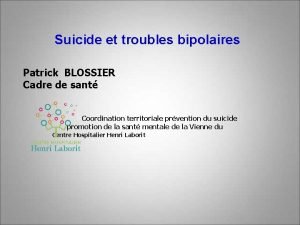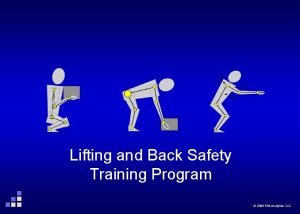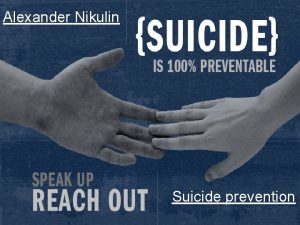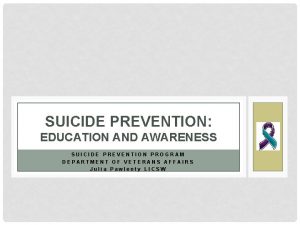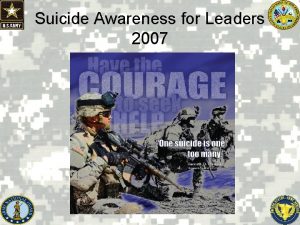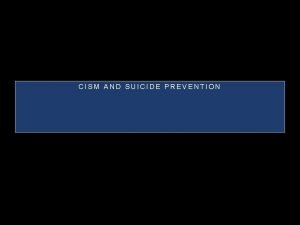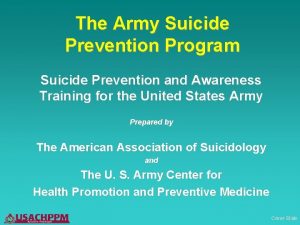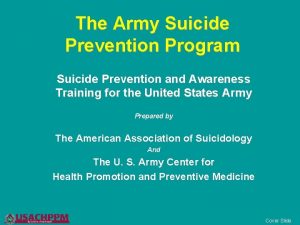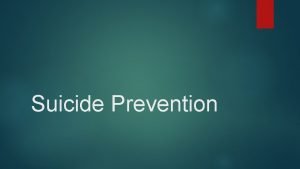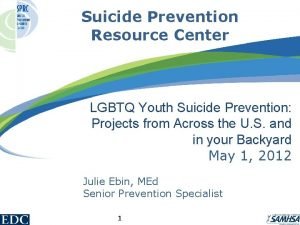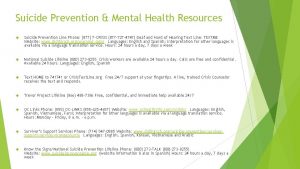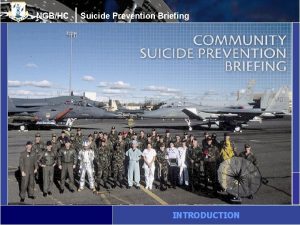Suicide Awareness and Prevention Learning Topics Suicide and















- Slides: 15

Suicide Awareness and Prevention

Learning Topics � Suicide and suicide attempt � Suicide gesture and behavior � Key risk factors � Protective factors � First responder � Ask � Care � Treat � MAD � Suicide resources � Hotline

Importance �Loss of life to suicide is of great concern within the Department of the Navy (DON). The goal of the Navy’s suicide prevention program is to help you recognize and understand suicide risk, protective factors, and how to help and effectively intervene.

Suicide and Suicide Attempt �Suicide: an intentional act resulting in one’s own death. �Suicide attempt: an intentional act, causing self- harm, where death would have occurred without direct intervention.

Suicide Gesture and Behaviors �Suicide Gesture: similar to a suicide attempt except there is NO attempt to kill ones self. �Suicide behaviors encompass a broad range of acts, including suicide attempts, gestures, threats, and suicidal thoughts.

Key Risk Factors �Four key risk factors increase the likelihood for suicide: 1. Mental health problems, such as depression 2. Substance abuse or increased alcohol use 3. Situations that a Sailor labels as “hopeless” 4. Suicide behaviors, such as: �Previous suicide attempts or suicide gestures �Hints or talk about suicide

Protective Factors �One strategy to prevent suicide is to reduce risk factors or strengthen and increase protective factors, such as: �Belief that it is OK to get help �Early intervention by the command �Good problem-solving and coping skills �Optimistic outlook �Positive attitude about getting help early �Positive family and social support �Spiritual support

First Responder �To be a First Responder, you must: �Know the warning signs of suicide �Let your shipmate, friend, or family member know that you are worried, concerned, and care about him/her �Take all talk about suicide very seriously �As a First Responder, you can follow the acronym ACT: �Ask �Care �Treat

ASK �DO: �Ask your shipmate if he/she is thinking about suicide �Actively listen to what he/she has to say �Acknowledge his/her talk, behavior, and feelings �DON’T: �Debate whether suicide is right or wrong �Discuss whether feelings are good or bad �Lecture the person on the value of life

CARE �DO: �Let your shipmate know you care and understand �Discuss and care about what is troubling him/her �Maintain good eye contact and give your undivided attention �Care if a shipmate has a plan for suicide �DON’T: �Encourage him or her to do it �Act shocked—this will put distance between you

TREAT �DO: �Obtain professional help as soon as possible �DON’T: �Leave the person alone �Be sworn to secrecy

Don’t Get Mad �DON'T: �Miss or mistake signals �Avoid the person �Disregard signals

Suicide Resources �Chaplains �Command leadership �Fleet and family support centers �Marriage and family counselors �Medical services �University resources

Hotline Insert Campus Hotline Here

Resources � American Association of Suicidology – http: //www. suicidology. org � Centers for Disease Control and Prevention http: //www. cdc. gov/Violence. Prevention/suicide/ � Navy and Marine Corps Public Health Center– http: //www. nmcphc. med. navy. mil/ � Navy Suicide Prevention Program – http: //www. public. navy. mil/bupersncp/support/suicide_prevention/Pages/default. aspx � Mental Health – https: //www. militarymentalhealth. org/welcome. asp � Military One. Source : www. miltaryonesource. mil � National Suicide Prevention Lifeline – http: //www. suicidepreventionlifeline. org/ � OPNAVINST 1720. 4 A
 Primary prevention secondary prevention tertiary prevention
Primary prevention secondary prevention tertiary prevention Mad acronym suicide prevention
Mad acronym suicide prevention Chapter 5 glencoe health answers
Chapter 5 glencoe health answers Suicide prevention chain teach
Suicide prevention chain teach Texas suicide prevention symposium
Texas suicide prevention symposium Suicide prevention sink
Suicide prevention sink Army suicide prevention situational questions
Army suicide prevention situational questions Prévention du suicide
Prévention du suicide Suicide prevention month quotes
Suicide prevention month quotes Army suicide prevention training
Army suicide prevention training Prévention suicide
Prévention suicide Privacy awareness and hipaa privacy training cvs
Privacy awareness and hipaa privacy training cvs Back safety training
Back safety training Cuadro comparativo de e-learning b-learning y m-learning
Cuadro comparativo de e-learning b-learning y m-learning Global citizenship education topics and learning objectives
Global citizenship education topics and learning objectives Cs 282r topics in machine learning
Cs 282r topics in machine learning




